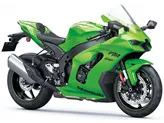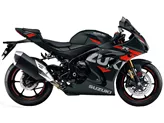Yamaha R1 2015 vs. Suzuki GSX-R 1000 2015

Yamaha R1 2015

Suzuki GSX-R 1000 2015
Overview - Yamaha R1 2015 vs Suzuki GSX-R 1000 2015
The Yamaha R1 2015 and the Suzuki GSX-R 1000 2015 are both supersport motorcycles that offer high performance and advanced features. However, there are some key differences between the two models.
In terms of engine specifications, the Yamaha R1 has a larger bore and stroke, resulting in a higher displacement of 998cc compared to the Suzuki GSX-R 1000's 999cc. This gives the Yamaha R1 a slight edge in terms of power, with 200 HP compared to the Suzuki's 185 HP. The Yamaha R1 also has a higher torque of 112.4 Nm compared to the Suzuki's 116.7 Nm. Both bikes have a 4-cylinder engine with DOHC valves, but the Yamaha R1 has a higher compression ratio of 13 compared to the Suzuki's 12.8.
In terms of chassis, both bikes have an aluminum frame, but the Yamaha R1 features a Deltabox frame while the Suzuki GSX-R 1000 has a Twin-Spar frame. The choice of frame design can affect the handling and stability of the bike, with the Deltabox frame offering a more aggressive and responsive feel.

Yamaha R1 2015
Both bikes have double disk brakes at the front, providing strong stopping power. They also have the same tire dimensions, with a front tire width of 120mm and a rear tire width of 190mm. The wheelbase and fuel tank capacity are also identical for both models.
In terms of dimensions and weights, the Yamaha R1 has a slightly higher seat height of 855mm compared to the Suzuki's 810mm. The Yamaha R1 also has a slightly lower kerb weight of 199kg compared to the Suzuki's 205kg. However, the Suzuki GSX-R 1000 has a slightly larger fuel tank capacity of 17.5 liters compared to the Yamaha R1's 17 liters.

Suzuki GSX-R 1000 2015
In terms of strengths, the Yamaha R1 is known for its crazy sound, rev-happy engine with a strong peak, and a great racing feeling in the saddle. It also boasts a superior electronics package and high-quality workmanship. On the other hand, the Suzuki GSX-R 1000 is praised for its sophisticated technology and wealth of experience from years of successful racing. It also offers a wide range of accessories for customization.
However, the Yamaha R1 does have some weaknesses. It experiences torque sag in the middle and may have stability issues in the braking zone. On the other hand, the Suzuki GSX-R 1000 is considered a bit outdated in terms of electronics and has a more subdued appearance compared to the Yamaha R1.
In conclusion, both the Yamaha R1 2015 and the Suzuki GSX-R 1000 2015 are powerful and capable supersport motorcycles. The Yamaha R1 offers a more aggressive and thrilling riding experience with its higher power and torque, while the Suzuki GSX-R 1000 brings a wealth of racing experience and a range of accessories. Ultimately, the choice between the two will depend on personal preferences and priorities.
Technical Specifications Yamaha R1 2015 compared to Suzuki GSX-R 1000 2015
Pros and Cons in comparison
Pros and Cons in comparison
Yamaha R1 2015

The new R1 is a big hit and no longer compares to the previous model. This was considered a good country road bike and heavy investments had to be made for excursions to the race track. Now it is the other way round. The new R1 has been developed with a clear focus on the race track. The electronics package seems outstanding, technology freaks will get their money's worth. Yamaha fans have to buy it, they finally have a worthy motorbike. The R1 has slight weaknesses when braking - it becomes a little unstable here. If you want to buy a ready-made racing bike without having to work on the chassis, you'd better go for the R1M. The Öhlins electronic suspension works perfectly and has no weaknesses. For pure racetrack use, the second weakness of the R1 can easily be ironed out. The torque hole in the middle can be easily ironed out with a new mapping.
Suzuki GSX-R 1000 2015

Many victorious years in international motorbike racing have made the GSX-R1000 superbike a legend - and a somewhat grey model. Real innovations or even revolutions are a long time ago, and the last updates were limited to visual upgrades, such as the MotoGP Replica paint scheme. It may look fresh and snappy, but in the segment of racers that have now advanced to technologically advanced and correspondingly expensive hyper-sports bikes, the GSX-R now looks like a slightly greying prototype. It still rides well, fast and harmoniously, you can just tell it's mature - and that's meant in a positive way. Nevertheless, we are already waiting for the next generation.
Price Comparison Avarage Market Price Yamaha R1 vs Suzuki GSX-R 1000
There are a few key differences between a Yamaha R1 2015 and a Suzuki GSX-R 1000 2015. It takes less time to sell a Yamaha R1 with 76 days compared to 83 days for a Suzuki GSX-R 1000. Since model year 2005 1000PS.de editors have written 80 reviews for the Yamaha R1 and 71 reviews for the Suzuki GSX-R 1000 since model year 2005. The first review for the Yamaha R1 was published on 28/04/2003 and now has more than 3,900 views. This compares to more than 7,100 views for the first review on Suzuki GSX-R 1000 published on 03/03/2004.
































